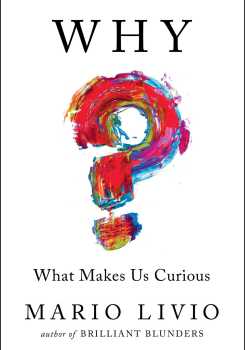The Curious Case Of…Curiosity
From child development to cognition, author and astrophysicist Mario Livio contemplates how we can shift our focus back on curiosity.
The following is an excerpt from Why?: What Makes Us Curious, by Mario Livio.
Curiosity has only relatively recently started to receive the focus it deserves. While many of the details of the mechanisms underlying curiosity are still unknown, at least a broad-brush understanding is beginning to emerge. What have we learned so far?
First, as children engage in increasingly complex activities, they explore their new environments and acquire fresh knowledge. The trajectory that they follow while growing up is remarkably similar for most children, which indicates common underlying mechanisms. Children’s curiosity seems to drive them along a path that increases knowledge and involves a well-suited decision process that maximizes learning and facilitates the discovery of causal links. Children seem to understand relatively early that every effect is associated with a cause in an unbroken chain of events. Their curiosity appears to assign value to competing tasks based on the potential of these tasks to enable discovery.
The exploratory behavior of adults also seems to follow rather consistent patterns, even in open-ended circumstances and in spite of individual differences. Artificial-intelligence researchers Frederic Kaplan and Pierre-Yves Oudeyer suggested that all of these elements could be captured in the context of a paradigm in which the goal of curiosity and exploratory behavior is to reduce prediction error to the extent possible. In other words, according to this view, humans (children and adults) avoid both extremely predictable and highly unpredictable exploratory routes in order to focus on those courses to satisfying curiosity that can maximize the rate at which their prediction errors decrease. Gottlieb, Kidd, and Oudeyer further clarified and expanded what they perceive as curiosity’s main “goal,” which they say is to maximize learning (rather than merely to reduce uncertainty).
What is curiosity really? In my humble view, the cognitive and neuroimaging studies appear to support a scenario in which what we refer to as curiosity may actually encompass a family of intertwined states or mechanisms that are powered by distinct circuits in the brain. In particular, the curiosity triggered by novelty, surprise, or puzzling stimuli—perceptual curiosity—seems to be primarily associated with an unpleasant, aversive condition. In this case, curiosity is a means to reduce the negative feeling of deprivation. This type of curiosity is adequately explained by the information-gap theory, and its intensity as a function of the level of uncertainty generally follows an inverted-U shape.
[Tapping into the creativity of brain difference.]

On the other hand, the curiosity that embodies our love of knowledge and the drive for its acquisition—epistemic curiosity— is experienced as a pleasurable state. In this case, curiosity provides an intrinsic motivation for its own sake. Consistent with this picture of different types of curiosity, perceptual curiosity was found to activate brain regions that are sensitive to conflict, while epistemic curiosity switched on brain areas linked to the anticipation of reward.
The satisfaction of curiosity (of any type) is closely related to the neural reward circuit, and it enhances memory and learning, especially when the information violates prior expectations and when the exploration is active and volitional. In the other direction, past rewards can trigger a higher level of curiosity, even without reminders or boosting.
[The many uses of ‘useless’ research.]
An interesting recent study suggests that even individual differences can be estimated with some confidence using fMRI. Neuroscientists Ido Tavor and Saad Jbabdi of the University of Oxford and their collaborators showed that fMRI imaging of a person’s brain while that individual is at rest, doing absolutely nothing, can predict which parts of the brain will be activated during a range of active tasks. Those tasks included reading (which involves language interpretation) and gambling (which is associated with decision making).
As I noted earlier, these new insights do not mean that we now understand curiosity. Curiosity is a topic where ideas jostle each other and everything can and is likely to change. Here are just a few of the basic questions neuroscientists and psychologists would like to have more complete answers to: Does curiosity play a role in maintaining cognitive abilities during adulthood? What are the precise similarities and differences between curiosity and other basic drives, such as hunger, thirst, and sexual desire? What are the main neural elements and mechanisms that govern and direct curiosity? How exactly does the brain merge those components to construct a clear course of decision making? What precisely underlies the individual differences in curiosity and exploratory drives?
Excerpted from Why?: What Makes Us Curious. Copyright © 2017 by Mario Livio, courtesy of Simon & Schuster.
Mario Livio is an astrophysicist and author of several books, including Galileo: And the Science Deniers (Simon & Schuster, 2020). He’s based in Baltimore, Maryland.